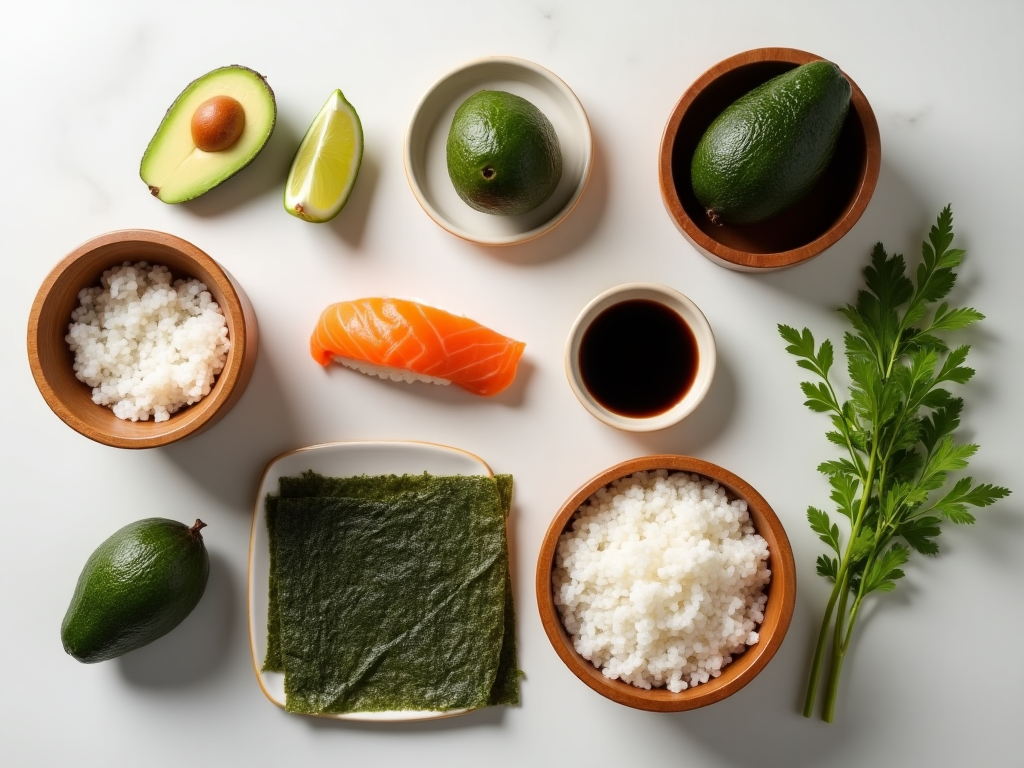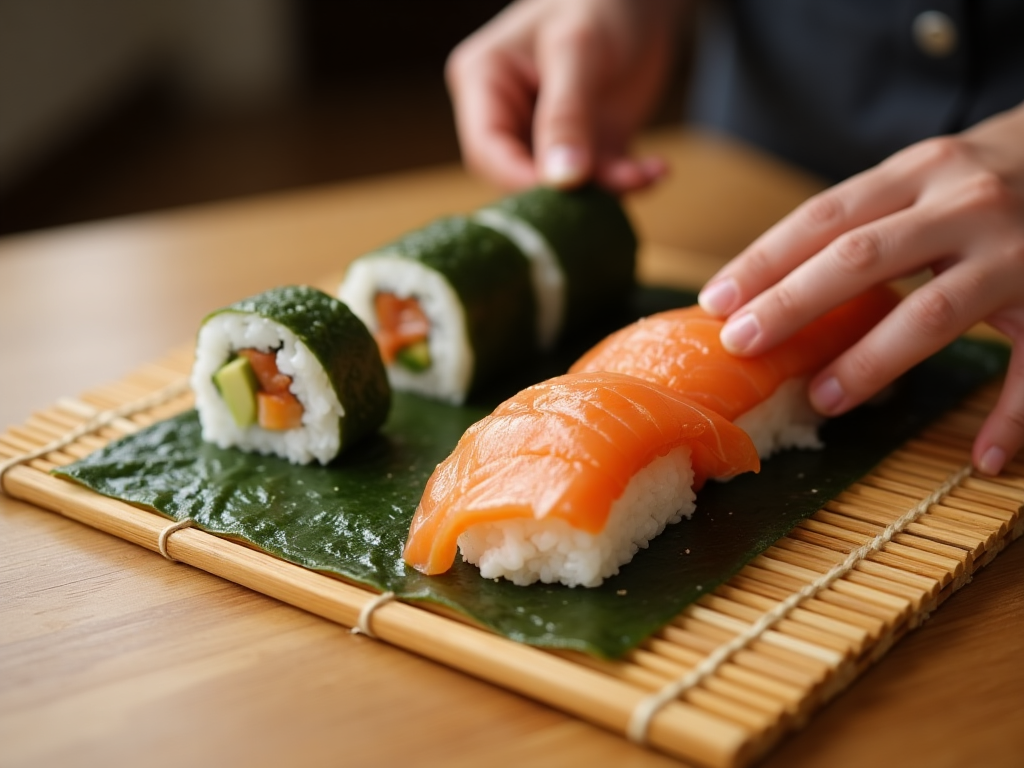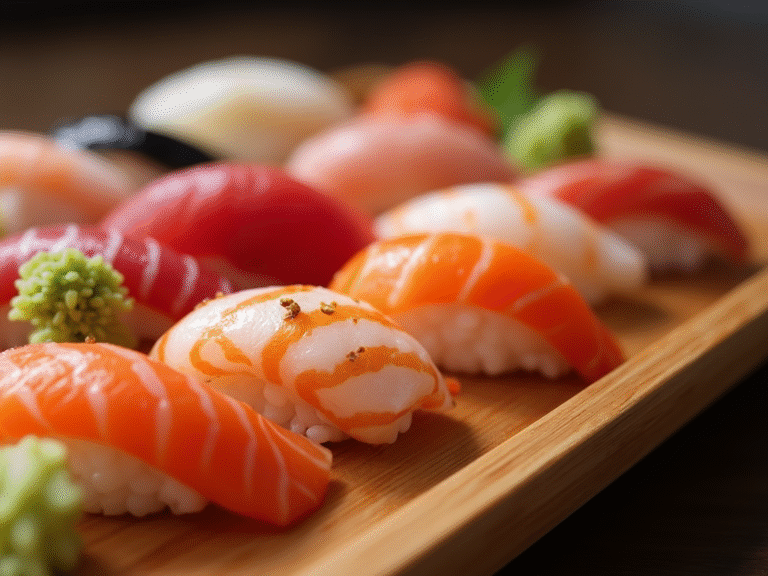Sushi Recipe | Homemade Sushi Rolls with Fresh Ingredients
Sushi Recipe: A Complete Guide to Making Homemade Sushi Rolls
Introduction
When it comes to comfort food, sushi may not always come to mind first, but it’s an incredibly satisfying and fun dish to prepare and enjoy. Sushi combines the beauty of fresh ingredients, delicate flavors, and satisfying textures. Making sushi at home isn’t as hard as you might think—it’s all about the right ingredients, a little technique, and a good deal of creativity.
Whether you’re a sushi enthusiast looking to expand your culinary skills or someone who just loves a good sushi roll, this Sushi Recipe is for you. You’ll learn how to make sushi at home from scratch, including how to prepare the perfect sushi rice, choose the best fillings, and roll your sushi like a pro.
So why will you love this recipe? It’s simple, customizable, and ideal for any occasion—whether you’re entertaining guests or just want to treat yourself to a homemade meal that’s both fresh and flavorful. Ready to dive in? Let’s get started!
Why You’ll Love This Recipe
- Fresh and Customizable: Sushi is all about freshness. You can adjust the ingredients to suit your taste, whether you like raw fish, vegetables, or a combination of both.
- Fun to Make: There’s something fun about rolling sushi with your hands. It’s like crafting your own little masterpiece with each roll.
- Perfect for Any Occasion: Whether it’s a casual dinner or a special event, sushi is an impressive and versatile dish that can be served as appetizers or a main course.
- Healthy and Delicious: Sushi features nutrient-packed ingredients like fresh fish, avocados, and seaweed, making it a healthy choice when paired with the right accompaniments.
Ingredients Breakdown
- Sushi Rice
Sushi rice is the foundation of any good sushi roll. The rice should be sticky, glossy, and perfectly cooked to hold its shape when rolled. Use short-grain sushi rice—not regular long-grain rice—as it’s the most important ingredient in achieving the right texture and stickiness. After cooking the rice, mix it with rice vinegar, sugar, and a pinch of salt for flavor.- Substitutes: If you can’t find sushi rice, you can use short-grain rice as an alternative, but sushi rice is recommended for the best results.
- Nori (Seaweed Sheets)
Nori is the dried seaweed used to wrap your sushi rolls. It adds flavor and texture to the sushi, as well as the signature green color. You can find nori sheets in most grocery stores or Asian markets. Choose high-quality nori for the best results.- Substitutes: If you prefer not to use seaweed, you can opt for soy paper or rice paper to wrap your sushi.
- Fresh Fish (Tuna, Salmon, or Your Choice)
Fresh fish is the star of many sushi rolls. Tuna and salmon are the most commonly used fish, but you can also use other types like yellowtail, snapper, or even shrimp if you prefer. Be sure to use sushi-grade fish to ensure freshness and safety when eating raw.- Substitutes: If you’re not keen on raw fish, try using smoked salmon or cooked shrimp. For a vegetarian option, fill your rolls with avocado, cucumber, or pickled radish.
- Avocado
Avocado adds a creamy texture and subtle flavor that complements the fresh fish. It’s often used in rolls like the classic California roll, but it works beautifully in any sushi roll. Slice it thinly to make it easy to roll and eat.- Substitutes: If you don’t like avocado, you can skip it or replace it with cream cheese, mango, or cucumber for different textures.
- Soy Sauce
Soy sauce is a must-have condiment for sushi. It’s used for dipping the rolls, adding a salty and umami flavor that enhances the taste of the fish and rice.- Substitutes: For a gluten-free option, you can use tamari or coconut aminos as a substitute for soy sauce.
- Pickled Ginger
Pickled ginger is typically served alongside sushi as a palate cleanser between bites. It has a sweet, tangy flavor and helps refresh your taste buds, making it a great addition to your sushi plate.- Substitutes: If you don’t like ginger, you can skip it or use a mild pickled daikon.
- Wasabi
Wasabi adds a spicy kick to your sushi. It’s usually served as a condiment alongside soy sauce. Wasabi has a sharp, pungent flavor that complements the delicate fish and rice. Use sparingly as it can be quite strong.- Substitutes: If you’re not a fan of wasabi, you can use horseradish mixed with a bit of mustard for a milder version.
Step-by-Step Instructions
- Prepare the Sushi Rice
- Rinse the sushi rice under cold water until the water runs clear. This removes excess starch and ensures the rice has the right texture.
- Cook the rice according to the package instructions, either on the stovetop or in a rice cooker.
- Once cooked, transfer the rice to a large bowl and let it cool slightly. Mix rice vinegar, sugar, and salt in a separate bowl and gently fold the mixture into the rice. Set the rice aside to cool completely.
- Prepare the Ingredients
- While the rice cools, slice your fish (tuna, salmon, or your choice) into thin strips. Make sure to use sushi-grade fish to ensure freshness.
- Slice the avocado into thin, even slices.
- Prepare any other fillings you like, such as cucumber, carrots, or pickled radish. Slice them into thin strips to fit into the roll.
- Set Up Your Rolling Station
- Lay a sheet of nori on a bamboo sushi mat, shiny side down.
- Wet your hands with water to prevent the rice from sticking, and spread a thin, even layer of sushi rice over the nori, leaving about an inch of space at the top.
- Add Your Fillings
- Place your fish, avocado, and any other fillings in a line across the center of the rice.
- Be careful not to overfill the roll—less is more, as too much filling will make it difficult to roll tightly.
- Roll the Sushi
- Starting at the bottom, carefully lift the sushi mat and roll the sushi tightly over the fillings. Roll forward, using the mat to keep the sushi compact.
- Once you reach the top edge of the nori, lightly wet it with water to seal the roll shut.
- Slice the Sushi
- Using a sharp knife, slice the roll into 6-8 pieces. Clean the knife with a damp cloth between cuts to prevent the rice from sticking.
- Serve and Enjoy
- Serve the sushi with soy sauce, wasabi, and pickled ginger on the side. Enjoy your fresh, homemade sushi rolls!
Tips and Variations
- Rice Consistency: Make sure your sushi rice is sticky enough to hold together. If it’s too loose, the rolls may fall apart.
- Tight Rolling: When rolling, ensure the sushi is tight but not overly compressed, which helps the rolls hold together without squashing the fillings.
- Creative Fillings: Get creative with your fillings. Try adding tempura shrimp, cream cheese, or even mango for a sweet twist.
- Vegetarian Options: Replace fish with avocado, pickled vegetables, or tofu for a vegetarian-friendly sushi roll.
- Low-Carb Option: For a low-carb version, you can use cauliflower rice instead of regular sushi rice.
Serving Suggestions
- Sides: Sushi pairs beautifully with miso soup, a simple green salad with sesame dressing, or edamame for a light, healthy meal.
- Pairing Drinks: Enjoy sushi with a cold glass of green tea, sake, or white wine like Sauvignon Blanc.
- Garnishes: Top your sushi rolls with a sprinkle of sesame seeds or nori strips for extra flavor and texture.
Storage and Reheating Instructions
- Storage: Sushi is best enjoyed fresh. However, if you have leftovers, store the rolls in an airtight container in the fridge for up to 24 hours.
- Reheating: Sushi should not be reheated as it will lose its texture and quality. It’s best to eat it the same day it’s made.
Recipe Notes
- Can Be Prepped Ahead: You can prepare the rice and slice the fish in advance, but it’s best to roll the sushi just before serving to maintain freshness.
- Bamboo Mat: A bamboo sushi mat is highly recommended for rolling sushi, but you can use a clean kitchen towel in a pinch.
Nutrition Information (Per Serving)
| Nutrient | Amount |
|---|---|
| Calories | 250 kcal |
| Fat | 9 g |
| Saturated Fat | 1 g |
| Carbohydrates | 30 g |
| Sugar | 3 g |
| Fiber | 2 g |
| Protein | 10 g |
| Sodium | 600 mg |
| Cholesterol | 25 mg |
| Calcium | 30 mg |
| Iron | 1 mg |
Nutrition information is an estimate and may vary based on specific ingredients used.
Recipe Card Summary
- Course: Main Course
- Cuisine: Japanese
- Servings: 4
- Prep Time: 30 minutes
- Cook Time: 0 minutes
- Total Time: 30 minutes
Ingredients
- 1 cup sushi rice
- 4 sheets nori
- 1/2 lb sushi-grade tuna or salmon
- 1 avocado, sliced
- 1/2 cucumber, julienned
- 2 tbsp soy sauce
- 1 tsp wasabi
- 1/4 cup pickled ginger
Instructions
- Rinse and cook sushi rice.
- Prepare fillings: slice fish and avocado.
- Lay out nori on bamboo mat, add rice, and layer fillings.
- Roll tightly and slice into pieces.
- Serve with soy sauce, wasabi, and ginger.
Notes
- For a vegan version, substitute fish with avocado or pickled veggies.
Health Benefits
- Fish: Rich in omega-3 fatty acids, which are great for heart health.
- Avocado: High in healthy fats and fiber, providing a creamy texture and additional nutrients.
Avoid These Mistakes
- Too Much Rice: Use just enough rice to cover the nori. Too much rice can make the rolls soggy.
- Overfilling: Keep the fillings simple and balanced to avoid overstuffing the roll.
FAQs
- Can I use cooked fish in sushi?
Yes, you can use cooked fish, such as shrimp or crab for sushi rolls. - How do I make sushi rice sticky?
Ensure you use sushi rice and mix it with vinegar, sugar, and salt to achieve the right stickiness. - Can I make sushi without a bamboo mat?
While a bamboo mat makes rolling easier, you can use a towel or do it by hand if necessary. - Can I substitute the rice for something else?
Yes, for a low-carb option, use cauliflower rice. - How long does homemade sushi last?
Sushi is best enjoyed fresh, but you can refrigerate it for up to 24 hours. - Can I add cooked vegetables to my sushi rolls?
Absolutely! Grilled zucchini or sweet potato would be delicious additions.
Final Thoughts
Whether you’re a sushi novice or an experienced home cook, making sushi at home can be a rewarding and fun experience. This sushi recipe is simple to follow, customizable, and perfect for any occasion. The fresh, vibrant ingredients make each bite feel like a celebration of flavors. So gather your ingredients, get rolling, and enjoy your homemade sushi! Let me know how it turns out for you in the comments below. Happy cooking!









